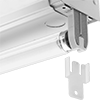Filter by
Voltage
Light Technology
Bulb Base Type
Bulb Shape
Color Temperature
Brightness
Environment
Mount Type
Color
Power Source
Screw-In Base Size
Beam Spread
DFARS Specialty Metals
Export Control Classification Number (ECCN)
Bulb Diameter
Lens Clarity
About Brightness
More
About Light Appearance
More


































































































































